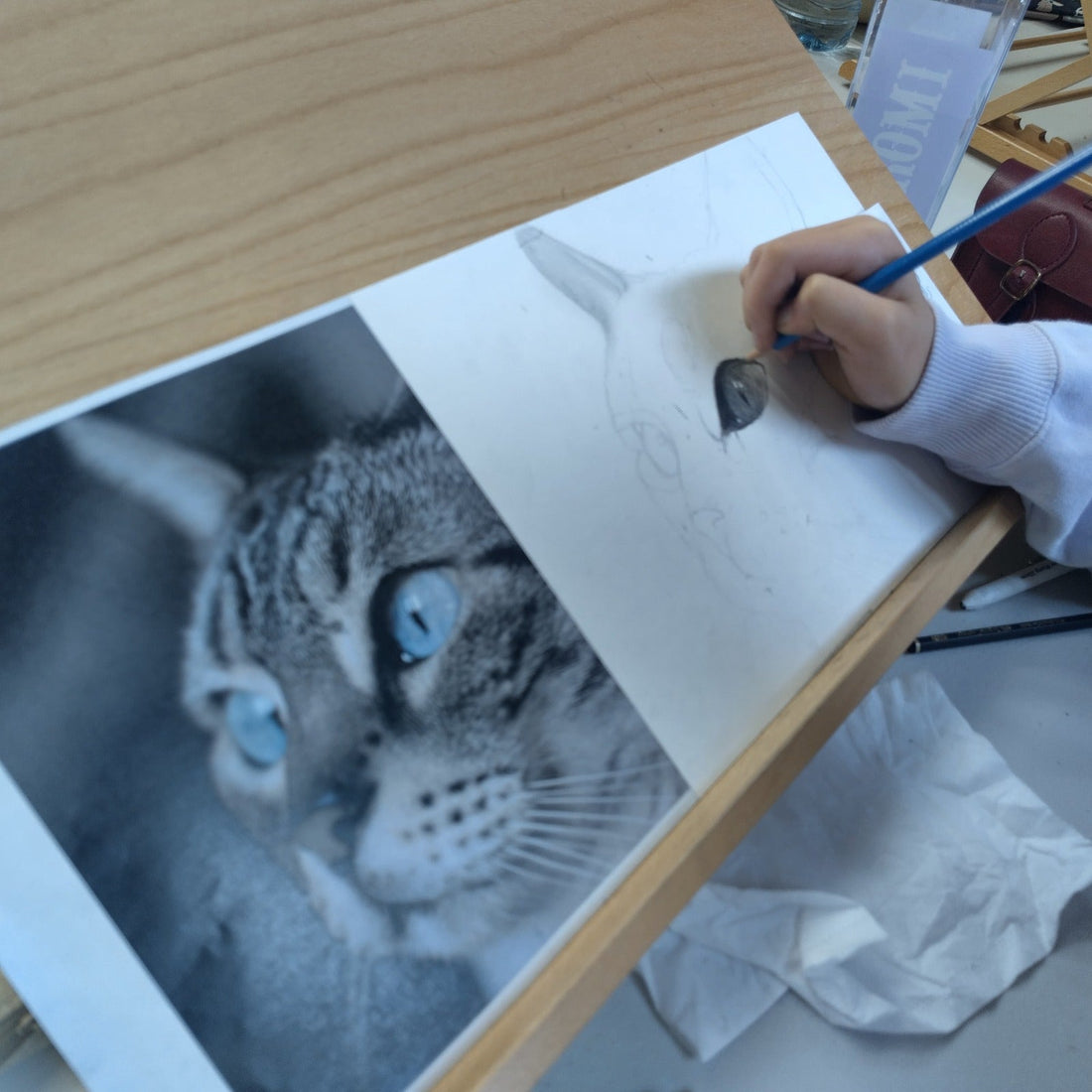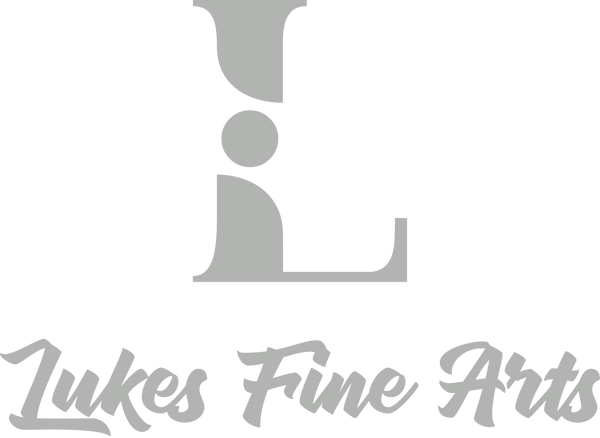
Why drawing what you see—not what you think you see—Makes all the difference in your artwork
Share
Writing blogs can be a lot of work. But in the mix of it all, its important to convey messages and stories that hold true to you, close to your heart, or will help bridge the gap for another. This blog is hands down, the latter. Once you learn this skill, this will transform your ability to draw massively. It wasn't until I was in class one day, that I realised what a problem this was! I was teaching a student trying to show them what to add into the drawing to take it to the next level, from great to amazing, showing them all of the shapes, shadows and lighting that they had missed. When suddenly the student blurted out, "how do you see all of that?!" Suddenly, I realised, that seeing the image for what it is, not what you think you see, is a skill that can be honed. This is why I start each and every one of my students on graphite pencil. With colour taken out you are forced to see your image in a reduction of grey, black and white. You have no choice but to look at the shadows, contrast and greyscale. This helps to train your brain to see the world (literally) in a different way. This actually happened to me. I remember when I first started using graphite pencil, I started seeing shadows and highlights in areas that I never had before, my brain was transforming the way I saw the world, it was phenomenal. But, if you are a hard-core colour fan, and don't want to change your medium to learn this lesson, here are some battle tested methods to see your drawing in a new way. In this blog I have added some general content of how to see your artwork in a new way and also some specific micro blogs around specifics, like eyes, seeing as this is something that many artists struggle with. So, without further ado lets dive in, to another blog about something that is close to my heart and will help you bridge another gap in your art journey!
Why drawing what you see is important.
Drawing what you see, not what you think, transforms your artwork. Symbolic drawing often distorts reality by relying on assumptions rather than actual details. Observational drawing, on the other hand, connects you directly with the subject—capturing true proportions, textures, and depth. This approach enhances accuracy and gives your work authenticity and precision.
The tendency to draw objects based on memory or assumptions and how this can affect your artwork in a negative way.
Relying on mental shortcuts can significantly hinder your growth as an artist. When we default to what we think we know, rather than observing carefully, we fall into the trap of symbolic drawing—where complex forms are reduced to generic symbols. Rather than accurately depicting what’s in front of you, drawing from memory or assumptions often results in oversimplified, distorted versions of reality. It’s common to assume you already know how things should look—whether it's the shape of a nose, the structure of a tree, or the curve of a hand—but these assumptions limit your ability to truly see and represent the subject as it is.
Over time, these mental shortcuts become deeply ingrained habits, making it difficult to recognise where your drawings are falling short. You may find yourself repeating the same visual patterns without even realising it, leading to work that feels flat, formulaic, or unrealistic. The real challenge—and the key to artistic growth—is learning to break free from these automatic responses. This involves retraining your eye to observe with intention and to translate what you actually see, not what you think you see. Direct observation helps you discover the subtle variations and hidden complexities that bring authenticity, depth, and life to your work. By embracing this shift, your drawings will become more precise, expressive, and grounded in reality.
Why drawing every eye, the same holds you back—and what to do Instead.
It’s easy to fall into the habit of drawing eyes the same way every time—especially if you’ve practised one version that “works.” But this shortcut often leads to portraits that feel generic, flat, or emotionally disconnected. The truth is, no two eyes are ever exactly the same. Even the same person’s eyes differ subtly from one another. Shape, size, placement, eyelid curve, fold depth, and iris position all vary from subject to subject—and these small differences are exactly where expression lives.
When you take the time to observe and draw the eyes in front of you—not the ones you’ve memorised—you begin to capture something far more powerful: the unique personality, mood, and emotional truth of your subject. Think of the slight squint in a smile, the asymmetry that reveals a quirk, or the heaviness in tired eyes. These aren’t imperfections—they’re the soul of your portrait.
To get better, slow down and study what makes the eyes you're drawing different. Ask yourself:
-
Is one eye slightly higher than the other?
-
Are the eyelids rounded, almond-shaped, or hooded?
-
Where exactly is the light hitting, and how does that affect the shadows?
-
Is the person relaxed, alert, suspicious, joyful?
By tuning into these details, you’ll not only avoid the trap of symbol drawing—you’ll create work that feels alive, human, and deeply connected. That’s where realism and emotional impact truly begin.
Why thinking of trees as simple lollipops limits your artwork
Reducing trees to simple shapes—like a round crown on a stick—is a common mistake that oversimplifies their natural complexity. While this may work as a quick placeholder or symbol, it strips away what makes trees so captivating in the first place. Trees are far from basic; they are intricate living systems with unique characteristics. Their bark has texture, their branches twist in unpredictable ways, and their foliage forms irregular patterns depending on the species, season, and environment. These organic variations are what bring authenticity and realism to your drawings.
When you limit yourself to seeing trees as just basic shapes, you miss the opportunity to capture their essence—the layered branches, the dappled light filtering through the leaves, and the subtle asymmetries that give them character. Your drawing may end up looking flat or cartoonish, rather than natural and grounded.
To take your tree drawings to the next level, slow down and observe them in their natural setting. Study how branches split and taper, how leaves cluster in space, how shadows fall unevenly across the bark, and how the trunk anchors the form into the ground. Take note of negative space between limbs and how light interacts with different surfaces. Even spending ten minutes sketching from life can help you see more clearly. The more you train your eye to notice these details, the more lifelike and engaging your drawings will become.
Remember: you’re not just drawing a tree—you’re interpreting a complex, living structure. By respecting its complexity, you give your artwork both depth and credibility.
Simple tools for observational drawing
Observational drawing is a skill that takes time and practice to master. Fortunately, there are simple tools and techniques that can help you achieve more accurate results. By focusing on direct observation—rather than relying on memory or assumptions—you can bring greater realism and detail to your work.
Let’s explore some of the most effective tools to refine your observational drawing skills:
Measuring proportions for accurate representation
Getting proportions right is essential to realistic drawing. The human eye understands size relationships, but it’s easy to misjudge them on paper. Using measurement tools can help ensure accuracy.
-
Use a pencil or ruler: Hold a pencil at arm’s length to measure objects in your reference. Then, compare lengths to maintain correct scale and proportions.
-
Check angles: Proportions aren’t just about size—they’re also about angles. Measuring relative angles helps prevent distortion in your drawing.
How to Use a Grid to Improve Accuracy
Using a grid is a powerful way to ensure accurate placements and proportions in your drawing. By breaking the reference into smaller sections, complex details become more manageable.
-
Draw a grid on your reference image: Use a ruler or software to divide your image into equal-sized squares. This breaks the subject into manageable parts.
-
Replicate the grid on your drawing surface: Match the reference’s proportions by drawing the same grid on your paper.
-
Focus on one square at a time: Work within each section, making sure the details match those in the corresponding part of the reference.
This method allows you to concentrate on each part of the image, ensuring nothing is overlooked.
Simple technique to spot errors: flipping reference images
Flipping your reference image—horizontally or vertically—is a surprisingly effective way to spot errors. When you’ve been looking at an image for too long, mistakes become harder to see. Flipping the image offers a fresh perspective and often reveals subtle inaccuracies you might otherwise miss.
The Power of Squinting to See Values More Clearly
Squinting is a classic artist’s trick—and for good reason. It helps you see broader tonal values and contrasts, rather than getting lost in fine details. This is essential for achieving realism in your work.
Benefits include:
-
Reducing visual noise
-
Identifying light and dark values
-
Simplifying complex scenes
These techniques sharpen your ability to focus on the essential elements of your subject.
Enhance composition and detail by focusing on shapes and negative space
When you draw shapes instead of labeling parts like “an eye” or “a hand,” you engage a more objective view of your subject. This approach helps you bypass preconceived notions and draw what’s actually there.
Benefits of shape-based and negative space drawing:
-
Improved proportions: Focusing on the space around an object helps clarify how parts relate to each other.
-
Enhanced composition: Negative space can bring balance and structure to your drawing.
-
Stronger detail: Observing the surrounding shapes sharpens your lines and makes your drawing more realistic.
-
Increased creativity: Seeing objects as abstract shapes opens you up to new ways of interpreting them.
This method boosts both accuracy and creativity—unlocking new dimensions in your work.
Exercises to break mental habits and improve observation
Improving your observational drawing skills goes beyond technical know-how—it involves training your brain to see differently. The following exercises are designed to disrupt old habits and encourage fresh perspectives, leading to more accurate, lifelike results.
Upside-down drawing: A fun way to see without preconceptions
Upside-down drawing helps you shift perspective and break free from mental shortcuts. When your reference image is flipped, your brain can no longer rely on memory. Instead of trying to recognize the subject, you focus on shapes and lines, leading to a more accurate and focused drawing.
How blind contour drawing sharpens focus
Blind contour drawing involves drawing the outline of a subject without looking at your paper. Your eyes remain on the subject while your hand traces its form.
Benefits include:
-
Improved hand-eye coordination
-
Increased focus and presence
-
Reduced reliance on assumptions
The results may look rough, but the practice develops a stronger connection between what you see and what you draw.
Ready to take your drawing to the next level? try this eye-opening challenge:
-
Flip your reference photo upside down.
-
Draw the image without turning it back.
-
This helps you focus on shapes, lines, and proportions instead of familiar labels like “eye” or “face.”
-
Without mental shortcuts, your brain engages with the subject more objectively—leading to improved accuracy and detail.
-
-
When finished, compare your drawing to the original.
-
You’ll likely notice sharper details and more precision in your second attempt.
-
This exercise helps you stop copying what you think you see—and start drawing like an artist. Give it a go, and discover how flipping your perspective can flip your entire approach to art!
